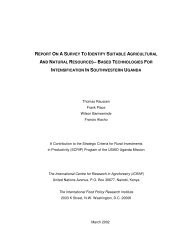Continuities in environmental narratives, Kabale, Uganda ... - Foodnet
Continuities in environmental narratives, Kabale, Uganda ... - Foodnet
Continuities in environmental narratives, Kabale, Uganda ... - Foodnet
You also want an ePaper? Increase the reach of your titles
YUMPU automatically turns print PDFs into web optimized ePapers that Google loves.
Africa-wide basis. 23 Information gathered <strong>in</strong> one colony was shared at such conferences 24 and ideas<br />
were also gathered from further afield. 25<br />
At a national level the major areas of concern were cash cropp<strong>in</strong>g areas. It was noted<br />
The old system of agriculture developed by the <strong>in</strong>digenous population <strong>in</strong> <strong>Uganda</strong> was<br />
excellent from a soil fertility po<strong>in</strong>t of view. With the rise of population, the <strong>in</strong>crease of food<br />
crops, of cash crops, and of cattle, serious stra<strong>in</strong>s are be<strong>in</strong>g put upon the old system and<br />
there is proof that soils <strong>in</strong> some parts of the Protectorate are los<strong>in</strong>g their fertility. The old<br />
system requires to be modified. 26<br />
The focus of attention was thus Eastern Prov<strong>in</strong>ce and Buganda which, be<strong>in</strong>g cotton produc<strong>in</strong>g areas,<br />
were the most important <strong>in</strong>come generat<strong>in</strong>g areas for the <strong>Uganda</strong>n adm<strong>in</strong>istration. But up to the<br />
early 1940s <strong>Kabale</strong>, not be<strong>in</strong>g a cash crop produc<strong>in</strong>g area, was rarely mentioned. From this<br />
emphasis it is clear that concerns about cash crops were crucial and it should be stressed that<br />
<strong>in</strong>itiatives at a national level <strong>in</strong> the 1930s (such as the Agricultural Survey Committee) were<br />
prompted as much by concerns over cotton yields, as by concerns over soil erosion. It may later,<br />
however, have suited the adm<strong>in</strong>istration to present these <strong>in</strong>itiatives as responses to concerns about<br />
soil erosion.<br />
Although <strong>Kabale</strong> was not a part of the discussions at a national level, concerns were be<strong>in</strong>g<br />
expressed at the district level. In 1935 the District Agricultural Officer (DAO) Wickham observed<br />
that crop yields were fall<strong>in</strong>g because of soil exhaustion <strong>in</strong> a 10 mile radius of <strong>Kabale</strong>. He observed<br />
that it was<br />
probable, though not yet determ<strong>in</strong>ed, that all crops <strong>in</strong> this area are ... deteriorat<strong>in</strong>g <strong>in</strong> yield,<br />
or quality. ...The reason for this state of affairs is clearly over population and soil<br />
exhaustion. There is not enough land available for the essential item <strong>in</strong> the rotation - fallow -<br />
to be <strong>in</strong>cluded at the proper <strong>in</strong>tervals. 27<br />
Wickham saw the problem as hav<strong>in</strong>g two related aspects - soil erosion due to cultivation of steep<br />
hillsides, and soil exhaustion due to lack of fallow and cont<strong>in</strong>uous cultivation caused by<br />
overpopulation. 28 He warned that ‘the position will <strong>in</strong>evitably and steadily become worse’ 29 and the<br />
area might cease to be self-support<strong>in</strong>g <strong>in</strong> food.<br />
Similar warn<strong>in</strong>gs were made by subsequent DAOs: Masefield expressed concern about the<br />
effect that fall<strong>in</strong>g yields was hav<strong>in</strong>g on the ability to collect sufficient fam<strong>in</strong>e reserves <strong>in</strong> some areas<br />
of Ndorwa. He observed that ‘the exhaustion of soil fertility is already becom<strong>in</strong>g a problem <strong>in</strong><br />
23 See for example PRO CO 822/106/5; PRO CO 822/109/10 1940; PRO CO 822/109/11; PRO CO 822/115/6.<br />
24 Conference of Directors of Agriculture, May 1940. Memo by the Dept of Ag Nyasaland ‘The Adaptation or<br />
Modification of Exist<strong>in</strong>g Native Agricultural Practices Towards Better Husbandry, Memo by Dept of Ag,<br />
Nyasaland.’ Entebbe National Archives [ENA] H304 ff1.<br />
25 For example Tothill went to India and South Africa <strong>in</strong> 1938 (See ENA H280 ff1) and Maher, from Kenya, and<br />
Hosk<strong>in</strong>g, from <strong>Uganda</strong>, were sent to the USA <strong>in</strong> 1938/39 to study erosion control measures. (See PRO CO 892<br />
15/7 and KDA Department of Agriculture [DoA] 19 ff211).<br />
26 Notes on Preservation of Soil Fertility under conditions of Native Agriculture <strong>in</strong> <strong>Uganda</strong>, by Tothill, Director of Ag<br />
written July 1935, ENA H175/1/II ff5. Also see ENA H218 I ff16(1) and KDA DC AGR-MNTH ff44Enc.<br />
27 Report for Year 1935 by Wickham, KDA DC AGR-MNTH ff53.<br />
28 Letter to DC from Wickham, DAO, <strong>Kabale</strong>, 5 Sept 1935, KDA DoA 009exp-c ff10. Note that soil ‘erosion’ (eg<br />
sheet or gulley erosion) and fall<strong>in</strong>g soil fertility or soil exhaustion are sometimes used <strong>in</strong>terchangeably.<br />
29 Report for Year 1935 by Wickham, KDA DC AGR-MNTH ff53.<br />
D:\_<strong>Uganda</strong> Land Use\SW land use and soils\Carswell papers\Carswell- Narratives paper-17 Dec.doc<br />
5
















